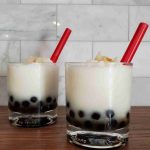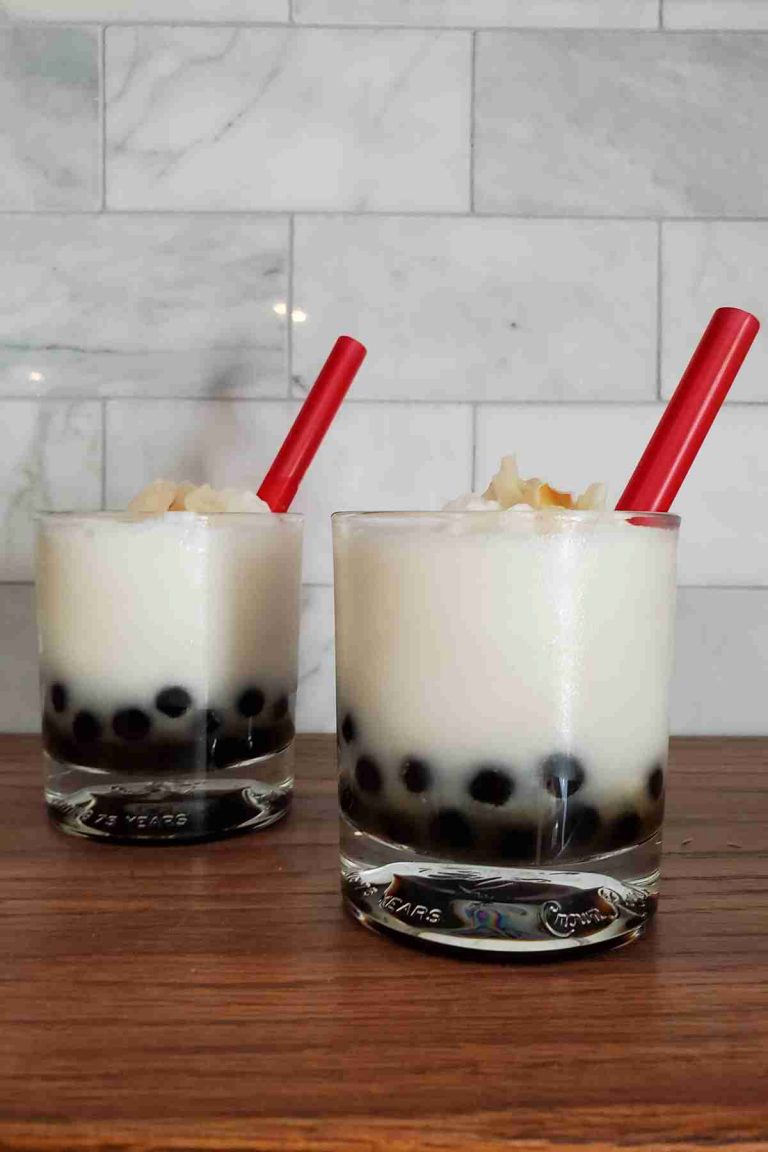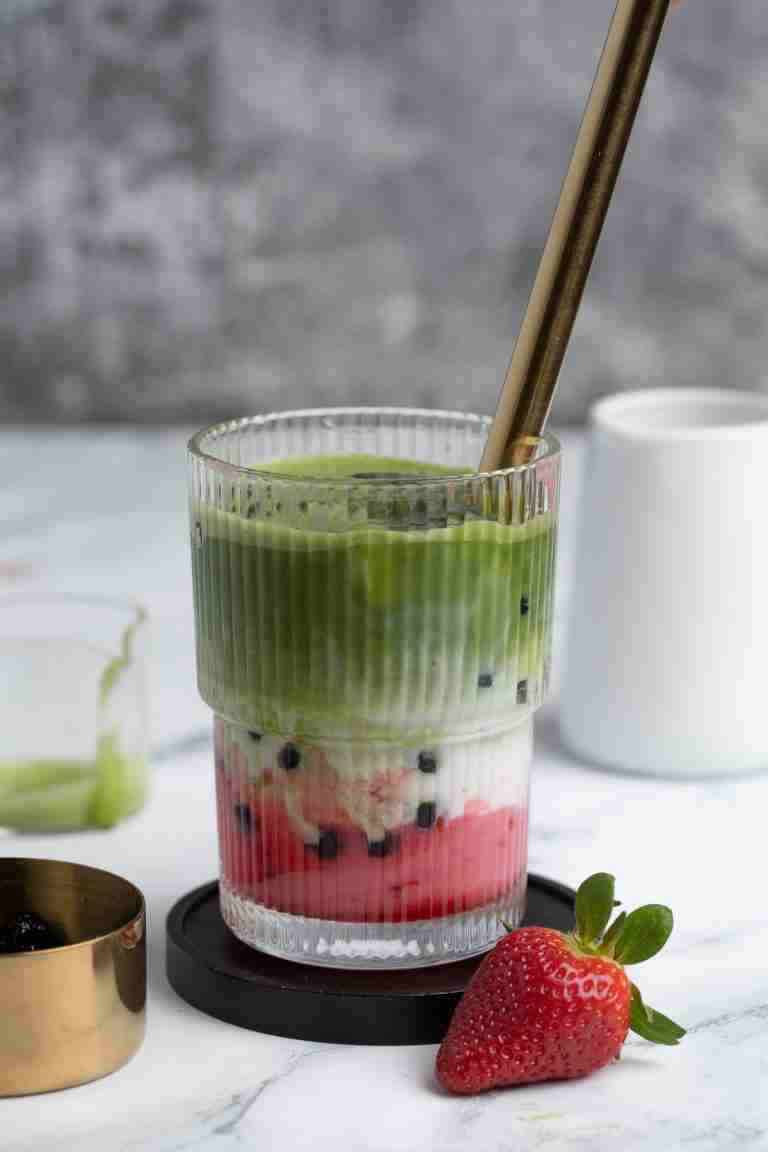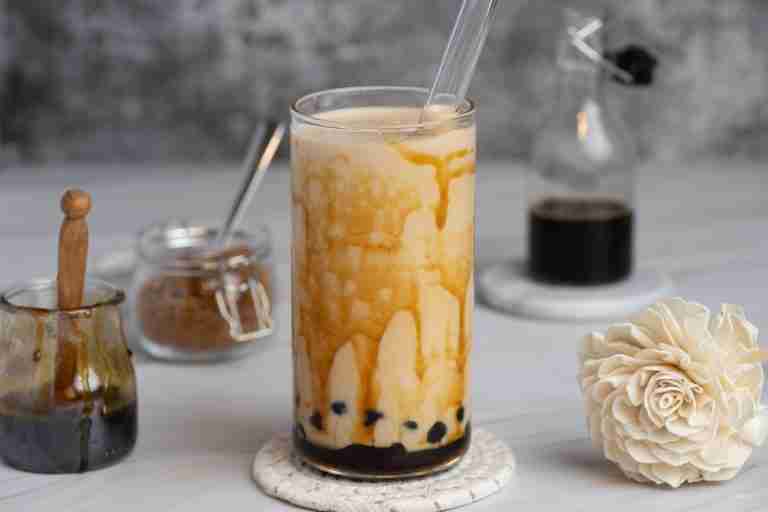This popping boba recipe is a fun way to make boba at home. Popping boba, also known as popping pearls or bursting boba, is usually enjoyed with bubble tea drinks such as iced milk teas, coffees, and ice-blended drinks.
In contrast to traditional boba balls which have a chewy texture, popping boba is not chewy at all. They have a jelly-like consistency and a thin skin that will burst when bitten, adding a quick explosion of flavor.
There are many different flavors of popping boba. The most common popping boba flavors are mango boba, strawberry boba, lychee boba, and passion fruit boba. My favorite is pairing for popping boba is lychee bubble tea. The iciness of the drink makes the popping boba settle in different layers and it looks really cool.
Popping boba is made through molecular gastronomy in a process called spherification. The specific process we will use in this recipe is the direct spherification method. This is a fun activity that kids can participate in too. All you need is a couple of tools and special ingredients to make this tasty topping.

Contents
How to make popping boba
To make popping boba, you mix components together to make a liquid solution. Then, a reaction occurs to form the boba balls. When made correctly, these balls encapsulate the juice of your choice. When you eat popping boba, you will hear and feel a pop after you break the skin and release the juice inside.
Popping boba is made through spherification, a process of encapsulating a liquid within a thin gel-like exterior, usually by using sodium alginate and a calcium salt. The sodium alginate we use is a seaweed extract. The options for calcium salts are calcium chloride, calcium lactate, or calcium lactate gluconate.
There are 3 types of spherification in molecular gastronomy: direct spherification, reverse spherification, and cold oil spherification.
- Direct spherification is easiest and simplest way to make popping boba with sodium alginate.
- Reverse spherification is an ideal method to use for liquids with a higher calcium content or contain alcohol, as the process is reversed and sodium alginate is not added to your liquid.
- Cold oil spherification is a useful method if you don’t have sodium alginate + calcium salt on hand or you don’t want to meticulously measure out everything to make sure you have the right concentration.
This post will explain how to do direct spherification only. You can learn more about using reverse spherification and cold oil spherification in those articles.
Direct spherification
The direct spherification method is best suited for popping boba that will be enjoyed immediately. Waiting over 1 hour to enjoy the boba will cause the boba to combine together until the entire sphere is a solid jelly.
You have many options for different juices and liquids to make different flavors of popping boba, but you want to choose liquids with these criteria:
- pH above 3.7. Use a litmus pH strips to verify that your liquid falls in the range. More acidic liquids will need to have sodium citrate added to raise the pH to at least 3.6.
- Little or no calcium content. High calcium liquids like milks or creams will cause the sodium alginate to instantly gel.
- No alcohol content. Sodium alginate can’t dissolve in alcohol.
If you want to make something with alcohol or calcium in the juice, I suggest trying reverse spherification.
Special equipment
The equipment and tools needed are:
- Measuring scale.
- Dropper, syringe, baster, caviar maker, or 1/4 teaspoon measuring spoon
- Slotted spoon
- Whisk
- Heat resistant bowl
- Blender or immersion blender (optional, but ideal)
What you need
Sodium Alginate, an important main ingredient needed for popping boba.
Calcium Salt (either calcium chloride, calcium lactate, or calcium lactate gluconate). This is the second main ingredient that interacts with sodium alginate to create popping boba.
Choice of liquid or juice to encapsulate. Fruit juices or fruit flavorings are most commonly used, like passion fruit, strawberry juice or mango juice. You can sweeten it further with sugar or add food coloring to increase the color’s vibrancy.
For liquids high in calcium (like dairy or orange juice) or that contain alcohol, you will not be able to do direct spherification method and will need to use the reverse spherification method. For more acidic drinks (lower than pH 3.6, add sodium citrate to get the pH to be at least 3.6).
Distilled water.
Measuring scale. To keep things accurate.

How to make popping boba (using direct spherification)
This process requires a little bit of patience and enthusiasm for science. You don’t need to be an expert at science, but you do need to be willing to learn to get better.
You may not get it right the first time, but after trying it again, you’ll get better and have popping boba in no time. I suggest to order extra materials so you can practice, get good, and show your friends or your kids.
Making the Solution
- Pour 300 milliliters of the juice or flavored liquid of your choice into a blender and blend on low.
- While blending, add 2 grams of sodium alginate and continue blending on low for 3-5 minutes.
- Pour into a bowl, cover, and place into the refrigerator for a few hours to allow the air bubbles created from blending to fully dissipate.
- In a large bowl, whisk 10 grams calcium lactate to 800 milliliters of distilled water until fully dissolved.
- Fill another bowl with distilled water and set aside for rinsing the popping bobas.
Making the balls
- Remove the chilled sodium alginate + juice mixture from the refrigerator.
- Stir the calcium lactate solution so the water is moving when you drop in the popping boba spheres. This helps keep them from sticking to each other.
- Using a dropper or syringe, dispense the sodium alginate + juice mixture drop by drop into the calcium lactate solution.
- This method will create pretty small spheres. If you prefer larger balls, scoop up the alginate + juice mixture using a 1/4 teaspoon measuring spoon and holding it just above the surface of the calcium lactate solution, slowly add the alginate + juice mixture to the calcium lactate solution without causing a large splash.
- You can use a caviar maker if you’re making a large amount of popping bobas.
- Allow the popping bobas to sit in the calcium lactate solution for 30 seconds before scooping them out with a slotted spoon and rinsing them in the distilled water bowl. If you made larger popping bobas using the 1/4 teaspoon measuring spoon, allow them to sit for 2 minutes before rinsing.
- Remove from the distilled water and your popping bobas are ready for some popping! Add them to your favorite boba milk tea, ice cream, or shaved ice.
Tips
- Make sure your measurements are accurate. Having an accurate measuring scale is essential to ensure the reaction happens properly. This is the measuring scale I recommend.
- Use a blender or immersion blender to mix in sodium alginate.
- Sodium alginate can be challenging to mix in thoroughly, so having a blender or immersion blender will help a lot.
- When using a blender, make sure there is enough liquid to cover the blades. If there isn’t, the sodium alginate tends to collect on the top of the blade instead of dissolving into the liquid.
- I have found that a dropper or syringe created spheres that were too small and I prefer using a turkey baster or measuring spoon.

Storing
Popping boba is best enjoyed immediately at room temperature and you may refrigerate them if you prefer, but it’s not required.
If you need to store the popping boba for a short period of time, store them in a small container filled with the original juice or flavored liquid that does not contain sodium alginate. Do not store them in distilled water as they will become diluted through osmosis.
Keep in mind that popping boba made via the direct spherification method will need to be used within 45 minutes to 1 hour as they continue to gel over time until the entire sphere is solid.
FAQs
What is the difference between popping boba and traditional boba?
Boba goes by many names: tapioca boba balls, tapioca pearls, bubbles, or boba. The one you see ordered the most at bubble tea shops, are traditional boba in the form of translucent black little chewy balls. They’re made from tapioca starch, which is derived from cassava roots.
Popping boba, on the other hand, is made by molecular gastronomy and usually contain varying juicy flavors.
Does popping boba contain gelatin?
No, these popping bobas do not contain gelatin.
Does popping boba contain gluten?
No, these popping bobas are gluten free.
Is popping boba healthy?
It’s healthier than regular boba because there’s less carbs and sugar if you choose a healthy liquid. Otherwise there is little nutritional value to popping boba.


Popping Boba Tea Recipe (The Simple Spherification Way)
Equipment
- Dropper, syringe, baster, caviar maker, or 1/4 teaspoon measuring spoon
- Slotted spoon
- Heat resistant bowl
- Blender or immersion blender (optional, but ideal)
Ingredients
- 2 grams sodium alginate
- 10 grams calcium salt (either calcium chloride, calcium lactate, or calcium lactate gluconate)
- 300 milliliter choice of liquid or juice to encapsulate
- 800 milliliter distilled water
Instructions
To Make the Solution
- Pour the juice or flavored liquid of your choice into a blender and blend on low.
- While blending, add sodium alginate and continue blending on low for 3-5 minutes.
- Pour into a bowl, cover, and place into the refrigerator for a few hours to allow the air bubbles created from blending to fully dissipate.
- In a large bowl, whisk calcium lactate to distilled water until fully dissolved.
- Fill another bowl with distilled water and set aside for rinsing the popping bobas.
- Remove the chilled sodium alginate + juice mixture from the refrigerator.
To Make the Balls
- Stir the calcium lactate solution so the water is moving when you drop in the popping boba spheres.
- Using a dropper or syringe, dispense the sodium alginate + juice mixture drop by drop into the calcium lactate solution.
- Allow the popping bobas to sit in the calcium lactate solution for 30 seconds before scooping them out with a slotted spoon and rinsing them in the distilled water bowl. If you made larger popping bobas using the 1/4 teaspoon measuring spoon, allow them to sit for 2 minutes before rinsing.
- Remove from the distilled water and your popping bobas are ready for some popping! Add them to your favorite boba milk tea, ice cream, or shaved ice.




